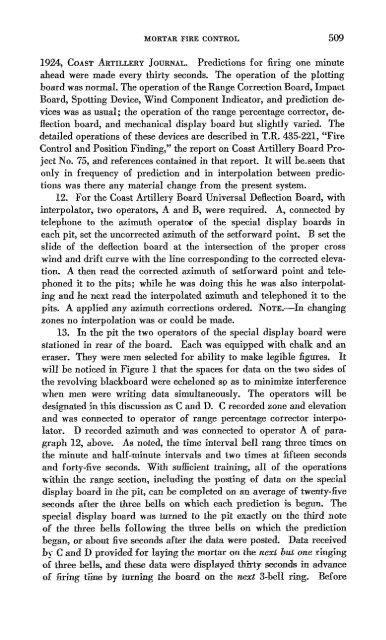COAST ARTILLERY, JOURNAL - Air Defense Artillery
COAST ARTILLERY, JOURNAL - Air Defense Artillery
COAST ARTILLERY, JOURNAL - Air Defense Artillery
Create successful ePaper yourself
Turn your PDF publications into a flip-book with our unique Google optimized e-Paper software.
MORTARFIRE CONTROL 509<br />
1924, <strong>COAST</strong><strong>ARTILLERY</strong><strong>JOURNAL</strong>.Predictions for firing one minute<br />
ahead were made every thirty seconds. The operation of the plotting<br />
board was normal. The operation of the Range Correction Board, Impact<br />
Board, Spotting Device, Wind Component Indicator, and prediction devices<br />
was as usual; the operation of the range percentage corrector, deflection<br />
board, and mechanical display board but slightly varied. The<br />
detailed operations of these devices are described in T.R. 435-221, "Fire<br />
Control and Position Finding," the report on Coast <strong>Artillery</strong> Board Project<br />
No. 75, and references contained in that report. It will be.seen that<br />
only in frequency of prediction and in interpolation between predictions<br />
was there any material change from the present system.<br />
12. For the Coast <strong>Artillery</strong> Board Universal Deflection Board, with<br />
interpolator, two operators, A and B, were required. A, connected by<br />
telephone to the azimuth operatOl" of the special display boards in<br />
each pit, set the uncorrected azimuth of the setforward point. B set the<br />
slide of the deflection board at the intersection of the proper cross<br />
wind and drift curve with the line corresponding to the corrected elevation.<br />
A then read the corrected azimuth of setforward point and telephoned<br />
it to the pits; while he was doing this he was also interpolating<br />
and he next read the interpolated azimuth and telephoned it to the<br />
pits. A applied any azimuth corrections ordered. NOTE.-In changing<br />
zones no interpolation was or could be made.<br />
13. In the pit the two operators of the special display board were<br />
stationed in rear of the board. Each was equipped with chalk and an<br />
eraser. They were men selected for ability to make legible figures. It<br />
will be noticed in Figure 1 that the spaces for data on the two sides of<br />
the revolving blackboard were echeloned sp as to minimize interference<br />
when men were writing data simultaneously. The operators will be<br />
designated in this discussion as C and D. C recorded zone and elevation<br />
and was connected to operator of range percentage corrector interpolator.<br />
D recorded azimuth and was connected to operator A of paragraph<br />
12, above. As noted, the time interval bell rang three times on<br />
the minute and half-minute intervals and two times at fifteen seconds<br />
and forty-five seconds. With sufficient training, all of the operations<br />
within the range section, including the posting of data on the special<br />
display hoard in the pit, can be completed on an average of twenty-five<br />
seconds after the three bells on which each prediction is begun. The<br />
special display board was turned to the pit exactly on the third note<br />
of the three bells following the three bells on which the prediction<br />
began, or about five seconds after the data were posted. Data received<br />
by C and D provided for laying the mortar on the next but one ringing<br />
of three bells, and these data were displayed thirty seconds in advance<br />
of firing tillie by turning the board on the next 3-bell ring. Before
















